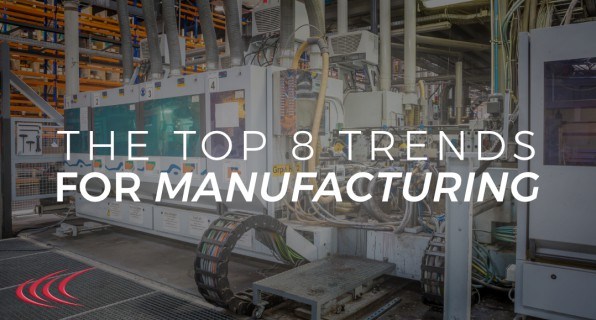2018 Manufacturing Trends
January 23, 2018
Adam Robinson

These are the 2018 Manufacturing Trends That will Drive 2.1% Growth In American Manufacturing
Manufacturing is on the cusp of an explosion in growth and innovation in 2018. Regulatory reform has been top-of-mind for supply chain executives and political leaders in the US since the 2016 election. The US energy industry is also awaiting changes in basic operating procedures, which are expected to dramatically reduce energy costs. These facts set the stage for exponential manufacturing growth in 2018. Supply chain executives need to take a few moments to learn more about the top 2018 manufacturing trends that will make it possible.
Check Out the Top 2018 Manufacturing Trends
1. Reshoring Continues to Become More Important
Reshoring is expected to be a major driving force and one of the most important of the 2018 manufacturing trends. The concept of reshoring is simple. Companies move operations that were previously moved overseas back to the US, and companies have already focused on the new administration’s legislation, especially the new tax bill, as a catalyst to move operations back to domestic grounds. As reshoring continues, more supplies will be needed, which has major implications for procurement professionals, as well as increased demand for new talent and more truck drivers.
2. Green Manufacturing Will Go Viral
Green Manufacturing is also expected to be a viable trend of 2018. Green technology and sustainability initiatives are “in.” Watchdog groups are looking for companies that engage in sustainable, eco-friendly practices, and manufacturers benefit from using green processes as well. Typically, they have less waste, rely on less energy and effectively increase profit margins.
3. Manufacturing Strategy Will Reduce the Burden of Costs of Transformation
Manufacturers are also ready to reinvent operational strategies. Strategies will focus more on consumer demands & experience, efficient workflows and partnerships with entities that may have previously been considered competitors. For example, more manufacturers are likely to begin the process of outsourcing services and transportation to 3PLs. In turn, this will dramatically reduce overall transportation costs for individual manufacturers, as well as reducing costs by increasing profit margins of national carriers, 3PLs, regional carriers, and even local delivery services.
4. Outcome-Based Pricing Will Not Come to a Head yet
Outcome-based pricing has been making the rounds and manufacturing circles for some time now, and it is the standard in medical and pharmaceutical parts of the supply chain. However, outcome-based pricing is not yet ready to take center stage in the mainstream manufacturing conversation. Everyday items, such as household products, clothing, electronics and recreational items are not ready to become part of the outcome-based pricing model, but it is on the horizon. Manufacturers should increase investment in research and product development departments throughout 2018 in advance of this expected trend over the next few years.
5. Manufacturers Will Expand for New Products and Services
Like increased focus on research and development, manufacturers will continue to expand existing product and service lines. Consumers are always looking for the newest technology, product and service, and manufacturers that continue operating with outdated product lineups are more likely to suffer setbacks in the loo of Amazon and other E-commerce giants.
6. Regulations and Trade Are Expected to Lessen
Regulatory reform is also going to be a trend that will make a splash in 2018. As regulations become less intense in 2018, manufacturers will have greater freedom to pursue new products, means of manufacturing and more. However, manufacturers should take every precaution necessary to avoid anything that could result in a negative pushback from the public.
7. Collaboration Becomes the New Standard in Manufacturing
Collaboration will also play a major role in manufacturing in the coming year. From 3PL partnerships to more information exchange between procurement and manufacturers, collaboration will effectively reduce costs, increase productivity, boost efficiency and reduce errors.
8. Risk Management Will Take Priority
Manufacturers and supply chain entities will refocus efforts to improve risk management in 2018. While economic experts predict amazing growth in the coming year, following new legislation, manufacturers should be cautiously optimistic. Risk management strategies will need to look at internal operations, focusing on how existing operations impact the entire supply chain, as well as factors not typically considered in risk management.
For instance, will a product or service result in an adverse consequence to the environment, consumers health, consumers financial matters or other factors? Manufacturers typically focus on what will bring in the greatest profit, but the level of scrutiny is so severe that risk management must evolve and become fact-based, considering both internal and external influences.
2018 Will Be a Year of Change Across All Manufacturers
Manufacturing will evolve in profound ways throughout 2018, and all Manufacturers will feel the effects of these eight 2018 manufacturing trends. However, manufacturers will also face additional pressures considering trends affecting employees, workplace safety and more. Those final trends will be explored in greater detail in part two of this series.
Click here for the original article









